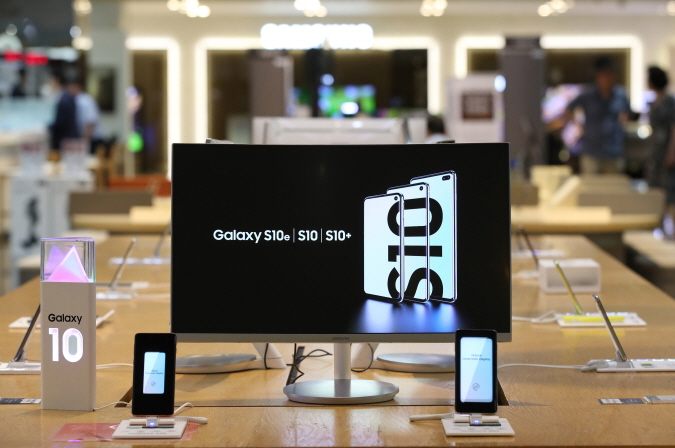SEOUL, Jul. 31 (Korea Bizwire) — Samsung Electronics Co. said Wednesday its second-quarter net profit more than halved from a year earlier on weak chip prices and tepid smartphone sales, warning Japan’s export curbs cloud its business outlook.
The net profit for the world’s largest chip and smartphone maker came to 5.18 trillion won (US$4.4 billion) in the April-June period, a 53.1 percent fall from a year earlier, the company said in a regulatory filing.
Its operating profit plunged 55.6 percent on-year to 6.59 trillion won, and sales slipped 4 percent to 56.1 trillion won in the three-month period, the firm said.
Samsung said the lower-than-expected memory chip prices weighed on its bottom line despite a slight recovery in demand in the second quarter.
The semiconductor business posted 3.4 trillion won in operating profits in the second quarter, the lowest since the third quarter of 2016.
“The weakness and price declines in the memory chip market persisted as the effects of inventory adjustments by major data center customers in the previous quarters continued, despite a limited recovery in demand,” Samsung said in a release.
Although the chip giant expected a gradual recovery in the demand side in the latter half of this year, it expressed concerns over rising uncertainties amid the prolonged trade war between the United States and China and, more recently, Japan’s export curbs on South Korea.
Japan began adopting stricter export rules on some key materials needed for making chips and displays on July 4 amid a diplomatic row over the issue of wartime forced labor.
Samsung is also preparing for Japan’s decision to remove South Korea from a list of trusted buyers as early as Friday, which would affect a broader range of high-tech materials.
“Even though the current Japanese measures don’t ban exports of the materials, the new export regulations add burden (on the company), and visibility is low on Japan’s trade measures,” Robert Yi, executive vice president for investor relations, said in a conference call.
“Company executives are preparing various measures to minimize its negative impact on the company.”
Samsung said it is hard to predict fresh cash flows due to global trade tension, delaying its earlier plan to announce its shareholder return policy to early 2020.
“In addition to already high uncertainties caused by prolonged global trade conflicts, the external environment regarding our component business has recently come under significant new challenges,” Yi said.
“As a result, we no longer believe it is possible to reasonably predict or forecast our free cash flow for 2018 through 2020.”
Although spot prices of memory chips surged in the weeks following the Japanese measures, Samsung said it is not yet clear whether the recent trend can drive up contract prices with its customers.
A spot price is the price currently traded on the market, while contract prices are negotiated as monthly or quarterly deals.
“A combination of various internal and external factors seems to have affected the spot prices, including the seasonality and concerns over future supplies following the Japanese measures,” Yi said.
“But it is hard to conclude whether it would affect the long-term contract prices of memory chips.”
Though its smaller rival SK hynix last week said it will cut memory output to deal with a supply glut, Samsung said it is not considering wafer input reduction at the moment.
The two Korean chip giants’ production plans are closely watched by investors as they produce over 60 percent of memory chips in the global market in 2018, according to market researcher IHS Markit.
Samsung expected prices of NAND, mostly used in mobile devices, will pick up in the third quarter, given the stabilizing inventory level and rising demand in the second quarter.
For DRAMs, the firm anticipated demand recovery in the third quarter as data centers resumed purchasing server DRAMs in the late second quarter but cautioned there would be more volatility in the market in the wake of global trade tension.
“In the second half, demand is expected to grow although the company sees volatility in the overall industry due to increased external uncertainties,” the company said, noting it will flexibly respond to the fast changing business environment.
The mobile division also posted lackluster profits despite strong sales of budget smartphones, the Galaxy A series, in emerging markets.
Although Samsung has upped the ante to invigorate the flattening smartphone market by releasing 5G smartphones in South Korea and the U.S., it failed to shore up its profits in the mobile division.
Samsung said it sold 8.3 million smartphones and 4 million tablets in the second quarter, predicting similar levels of shipments in the third quarter.
To boost demand in the premium segment, the firm plans to release its latest phablet, the Galaxy Note 10 in August and Galaxy Fold in September.
Samsung had planned to release the foldable device in April but delayed the release to September as it took time to fix some durability issues.
“We will sell a limited volume of Galaxy Folds in limited countries this year and expand foldable products in various forms,” a Samsung official said during the conference call.
“We expect the Galaxy Note 10 to achieve higher sales volume than its predecessor, the Note 9.”
The network business showed solid results on the commercialization of 5G service in South Korea, the firm said, adding it will step up efforts to expand global presence in the 5G market.
In contrast, the display division was a rare bright spot for the South Korean tech firm, which has strength in the flexible OLED displays used in premium smartphones.
Samsung said the display division, which logged operating losses in the first quarter, turned to the black with 750 billion won of operating earnings thanks to a one-time profit, without going into detail.
Market watchers speculated that the one-time profit was related to Apple’s reimbursement of unrealized OLED display sales following weaker-than-expected sales of iPhones.
The consumer electronics division was boosted by strong sales of new appliance products, but profits from TVs fell slightly from a year earlier due to intensifying competition.
Shares of Samsung Electronics fell 2.58 percent to 45,350 won on the Seoul bourse, underperforming KOSPI’s 0.69 percent decline. The quarterly results were released before the market opening.
(Yonhap)








